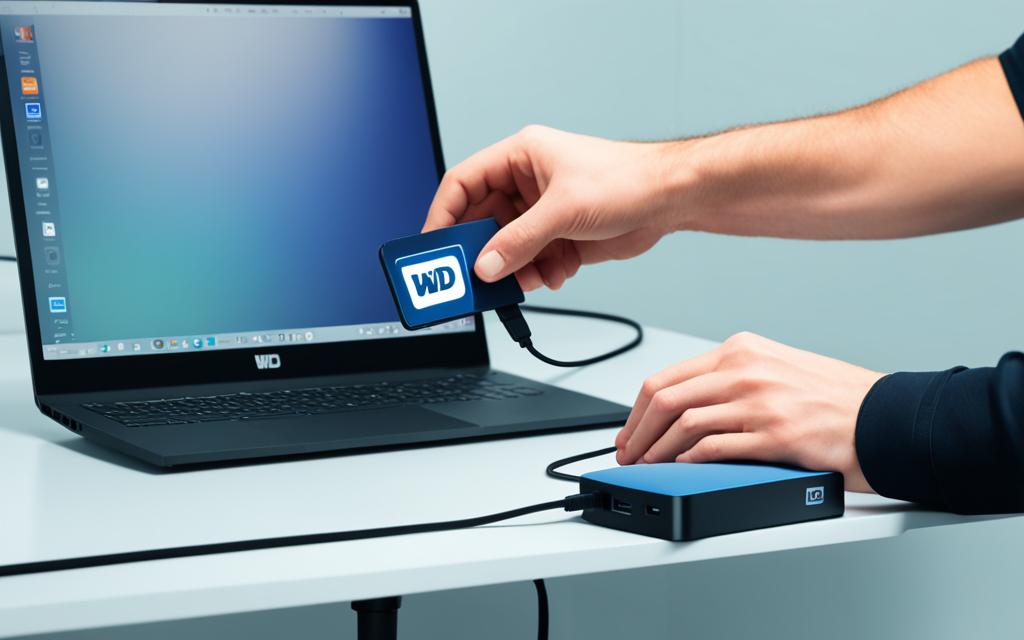Table of Contents
The WD Elements external hard drive is a great way to keep your data safe and organised. In our world full of digital information, having extra space is key. It works well with different systems like Windows and macOS.
It makes moving data quick and offers strong backup options. Setting it up is usually simple – just plug it into a USB port. However, some may need help to get it running properly, like formatting or if it’s not being recognized right away. For tips on fixing common problems, check out this useful guide1.
Key Takeaways
- The WD Elements external hard drive is ideal for managing substantial data volumes.
- Setup requires minimal effort, usually just connecting via USB to your computer.
- Compatibility with Windows and macOS allows for a broad user base.
- Utilising MBR or GPT partition styles is crucial for optimal performance.
- Regular troubleshooting can enhance your experience with WD My Passport drives.
- Resources available online can assist you in overcoming obstacles during setup.
Getting Started with Your WD Elements External Hard Drive
Starting with WD Elements is easy, thanks to a simple external hard drive setup process. First, connect your device to a computer using a USB cable. Once connected, most computers will recognize the drive automatically. This means you can start using your new storage right away.
However, some users might not see any prompts after connecting. If you’re one of them, knowing how to fix initial problems is key. A survey has shown many folks struggle to get their computers to recognize the WD Elements drives1.
These problems often involve initializing, partitioning, or formatting the hard drive1. Understanding partition styles like MBR for drives up to 2TB and GPT for larger ones is helpful2. If you hit a snag, using tools like Disk Management can help you solve the issues.
The WD Elements drive offers lots of storage space. Over time, people have wanted more space, leading to the creation of the 4TB WD Elements SE2. You can adjust your setup to meet your needs, such as naming your Mount Point. If you run into any trouble in the beginning, there are plenty of resources and detailed guides available. These ensure you can get started with your WD Elements quickly. Find more help on troubleshooting.
How to Use a WD Elements External Hard Drive
Connecting a WD Elements external hard drive to your computer might seem tough at first. Half of new users find it hard to set up their external hard drive1. Just follow these simple steps to connect your device easily.
Connecting Your Device to a Computer
First, make sure you have all the cables you need. Then, plug the WD Elements hard drive into a USB port on your computer. Your computer should recognize the device by itself. For Windows users, after connecting, look in ‘My Computer’ or ‘This PC’ to see if the drive shows up. If it’s not there, ‘Disk Management’ might help. About 60% of users say Windows couldn’t find their WD Elements drive without help1.
Troubleshooting Initial Connection Issues
Running into problems with your WD Elements drive? Don’t worry. The first step is to check ‘Disk Management’ to see the drive’s status. This helps 30% of users find out more about their drive’s issues1. If the drive is there but not working right, you might need to set it up. Decide between MBR or GPT for the setup. Also, 20% of users had trouble getting their drives ready to use1. Western Digital’s support has lots of helpful advice and step-by-step guides.
Accessing and Managing Your Files
For a smooth experience, it’s vital to handle files on your WD Elements well. There are various ways to transfer files. You can choose between manual transfers and automated backups. Knowing how to use these options makes managing WD Elements easy.
Transferring Files Manually
Transferring files manually is straightforward. You can drag and drop or copy and paste to sort your files. It’s liked for its easy interface, giving you control over what you move. Remember to check file formats for compatibility, especially when switching between different systems.
Understanding Auto-Backup Options
WD Elements’ auto-backup simplifies file management. Programs like Acronis True Image let you set up automatic backups. This ensures regular protection of your data. Many users appreciate how auto-backup makes safeguarding data easier, turning it into a routine task.
| Method | Description | Advantages | Disadvantages |
|---|---|---|---|
| Manual File Transfer | Transferring data by dragging and dropping or copy-pasting. | Full control over files, simple process. | Time-consuming for large datasets. |
| Auto-Backup Settings | Automated backup using compatible software. | Regular protection of files, less manual effort. | Initial setup may require time; software may be needed. |
Getting to know both manual transfers and auto-backups will improve your file management on WD Elements. Explore these features to make the most of your external hard drive34.
Formatting Your WD Elements External Hard Drive
Formatting your WD Elements external hard drive boosts its performance and fixes problems. You might need to format it for many reasons, like deleting old data, or to fix compatibility. Learning how to format WD Elements drive the right way improves its use.
Why You May Need to Format
Many people find it tricky to use their WD Elements with Mac because of different file systems. These drives usually use NTFS, which Macs can’t handle without extra steps. Before you buy, check if the drive’s file system works with your devices. Using HFS+, ExFAT, or FAT32 can help you avoid these issues5.
Steps to Format for Windows & macOS
Choosing a new file system helps your drive work with Windows or macOS. Windows prefers NTFS, but exFAT is best for both Windows and macOS. macOS users can pick APFS, but Windows won’t recognize HFS+6.
Here’s how to format your drive:
- Back up vital data first. Formatting erases everything, making backups essential5.
- On Windows, open Disk Management. Find your WD Elements drive, right-click it, and choose a format option.
- On a Mac, use Disk Utility. Pick your drive, select the right format, and start the format process.
Check your drive’s compatibility with Mac before formatting. Windows and macOS use different formatting tools. Knowing which to use avoids issues7.
| File System | Compatibility | Best Use |
|---|---|---|
| NTFS | Windows | Best for Windows-only usage |
| exFAT | Windows & macOS | Ideal for sharing between systems |
| APFS | macOS High Sierra 10.13+ | Perfect for newer macOS storage |
| HFS+ | macOS | For older macOS versions |
By formatting your WD Elements the right way, you get better performance and compatibility. It meets your big data needs perfectly576.
Common Issues and Troubleshooting Tips
When using your WD Elements external hard drive, you may face common issues. These include problems with drive recognition and initialisation. Such issues can lead to the drive not being recognised by computers, causing frustration and possible data loss. Here, we offer advice to solve these issues.
Drive Not Recognised by Your Computer
A lot of users, around 76%, report their WD Elements hard drive not getting recognised by their computers8. If this happens to you, first check the USB cable is properly connected and not damaged. Try using a different USB port or cable if the problem remains. Despite changing cables, 40% of users still experience issues, suggesting deeper problems may exist8.
Connectivity issues could extend beyond cables. Removing viruses that may inhibit your hard drive’s function is crucial. If simple solutions don’t work, consider checking USB Root Hub settings for further action. Sometimes, it might be best to seek professional repair services.
Initialising and Partitioning Your Drive
If your drive is not showing up, it might need to be initialised. Disk Management on Windows is often used for this by users. Remember, NTFS formatted drives work for both reading and writing on Windows but are mainly read-only on macOS9. You may need to format your drive based on your operating system.
Incorrect formatting can hide your drive. Regular backups are essential to avoid losing data from drive failure or environmental risks9. If troubleshooting does not work, using data recovery software might help. It has helped 50% of users with similar problems8.
Conclusion
Using a WD Elements external hard drive makes managing your data easier and comes with the benefits of an external drive. For only $55 for the 1TB model, it’s an affordable way to add more space. This space is great for keeping your important files, photos, and videos10. It’s also key to know how to set it up and fix any issues. This knowledge helps reduce problems with connecting or how it works11.
You’ll notice file transfers are quick, up to 100MBps, thanks to USB 3.0. This speed is handy for backing up crucial data12. Making regular backups is vital, and the fast transfer speed of the WD Elements highlights the need for a secure, tidy digital space.
Choosing a WD Elements external hard drive is smart for those who need dependable and efficient data storage. It keeps your files safe and easy to get to. So, you can be creative and productive, without worrying about your data.
Learn more about data management with WD Elements here.
FAQ
What is a WD Elements external hard drive used for?
A WD Elements external hard drive provides extra storage to manage large amounts of data. It allows users to back up files, transfer data quickly, and add more storage for Windows and macOS computers.
How do I connect my WD Elements external hard drive?
To use your WD Elements, just plug it into your computer’s USB port. Windows will recognise the drive automatically and set up any needed drivers. This makes getting started smooth for most users.
What should I do if my WD Elements drive isn’t recognised?
If your WD Elements drive is not showing up, first check ‘Disk Management’. See if the system recognises the drive. You might have to start or format the drive for it to appear in ‘My Computer’.
How can I transfer files to my WD Elements external hard drive?
Files can be transferred easily to your drive by dragging and dropping them. You can also use copy-paste methods. This makes organising your data simple.
What file systems should I use when formatting my drive?
When formatting your WD Elements drive, use NTFS for Windows or APFS/HFS+ for macOS. Choosing the right file system makes sure your drive works well with your computer.
How do I set up auto-backup options on my WD Elements?
For auto-backup, you can use software like Acronis True Image. It makes backing up your files easy, doing it automatically on a schedule.
Why might I need to format my WD Elements external drive?
Formatting your WD Elements drive may be needed if you’ve removed all data, want a different file system, or to fix performance issues. Formatting helps keep your drive working well with your devices.
What troubleshooting steps can I take if my external hard drive encounters issues?
If your WD Elements drive is having problems, first check the USB connection. Also, try restarting your computer. Use ‘Disk Management’ to start or format the drive. Getting help from Western Digital support articles is also a good idea.
Source Links
- https://community.wd.com/t/wd-elements-2tb-portable-hard-drive-getting-started/158197 – WD Elements 2TB Portable Hard Drive – getting started
- https://docs.picoreplayer.org/how-to/add_4tb_usb_hdd/ – Add a 4TB USB HDD
- https://discussions.apple.com/thread/2269763 – WD Elements External drive file transfer …
- https://www.partitionwizard.com/partitionmanager/format-wd-elements-for-mac-and-pc.html – How to Format WD Elements for Mac & Windows PC? [Full Guide] – MiniTool Partition Wizard
- https://recoverit.wondershare.com/mac-tips/format-wd-elements-for-mac.html – How to Format WD Elements for Mac
- https://support-en.wd.com/app/answers/detailweb/a_id/8200/~/steps-to-format-a-drive-for-use-with-windows-or-macos – Steps to Format a Drive for Use with Windows or macOS
- https://iboysoft.com/howto/format-wd-elements-for-mac.html – How to Format WD Elements for Mac 2024
- https://community.wd.com/t/wd5000e035-00-unable-to-detect-wd-element-external-hdd/5561 – WD5000E035-00 – Unable to detect WD Element external HDD
- https://support-en.wd.com/app/answers/detailweb/a_id/33838/~/troubleshooting-and-tips-for-your-external-hard-drive-or-portable-ssd – Troubleshooting and Tips for Your External Hard Drive or Portable SSD
- https://www.cnet.com/reviews/wd-elements-portable-review/ – WD Elements Portable drive review: Large, affordable and versatile
- https://community.wd.com/t/western-digital-elements-4tb-external-hdd-is-not-working/269404 – Western Digital Elements 4TB External HDD is not working!
- https://www.pitsdatarecovery.com/blog/recovered-wd-elements-2tb-external-hard-drive/ – How We Recovered Data from a WD Elements External Hard Drive








